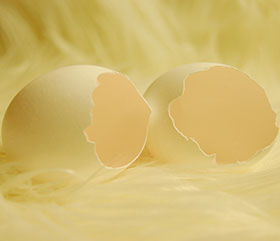

Methods of farming chickens vary from country to country, however the general temperature and humidity conditions required for the three stages of chicken lifecycle are always similar. Temperature and humidity measurement are required for each stage.
Incubation
Eggs are kept in the incubator for a total of 18 days. There are two schools of thought on the correct humidity level to use during this stage. The most popular condition for incubating the eggs is 53% RH @ 37°C. Towards the end of the incubation period, the eggs will start to release CO2, which starts to build up in the incubator. Valves open to vent this excess and keep the CO2 close to atmospheric levels, which has the side effect of venting water vapour and reducing the humidity level inside, therefore humidifiers are used to compensate for this to keep the level around the required 53%.
Some customers see better uniformity of the chicks when they are incubated in a higher humidity initially – 60% or higher in some instances (still at 37°C). They still vent the excess CO2 towards the end of the incubation cycle, but do not replace the water vapour lost at this stage.
Measurement
The measurement in this environment is fairly clean, and after 18 days, the eggs are moved to another room. Cleaning methods will vary from site to site, but typically are non-invasive. The sensors here typically will have a longer lifetime than those in other areas of the farm.
Hatching
Following the 18 days of incubation, the eggs are moved to the hatcher where they spend a total of 3 days. This cycle also begins with a condition of 53% RH @ 37°C. As soon as the chicks begin to hatch, the humidity level naturally increases, up to around 80%. This higher humidity actually assists the other chicks by making the shells slightly softer, allowing them to hatch more easily.
As the chicks hatch, CO2 levels also increase, so ventilation and humidification starts. Once all the chicks are hatched, humidity will be maintained around 60%.
As in the incubator, if the egg tray is not completely full then the level of humidification will need to be higher to maintain the required 53% level.
Measurement
This is a more demanding measurement as the hatching is a messy process. After the chicks are removed, the room will be decontaminated by pressure-washing with a mixture of water and disinfectant. It is this stage which is particularly damaging to the sensor, which should ideally be removed, or at least covered up. while this cleaning process is taking place.
Adult chickens
Normal body temperature for chickens is 41,5°C, however this will fluctuate depending on environmental temperature. Maintaining a constant body temperature is not a problem when air temperature is at least 10-15 degrees less than body temperature, but air movement is critical. A bird can only give off heat to its environment if the temperature of that environment is cooler than the bird. If heat produced by the birds is not moved away from them and out of the poultry house quickly, it will be more difficult for them to avoid heat stress.
The ambient temperature should be maintained at less than 25°C to avoid stressing the chickens, but more importantly, the environmental temperature should be kept as stable as possible. Fluctuations in the temperature, especially in combination with high relative humidity, will be more stressful to the birds than a high ambient temperature alone.
Measurement
This is the toughest measurement of the three: any sensors installed into the living environment or on the air outlets will experience drift over time, due to the NH3 content in the air. There is also a significant amount of dust in the air, which can cause premature failure on sensors with inadequate filtration.
By far the best location for controlling this environment is on the fresh air inlet.
Cleaning will also periodically take place in this environment, and the same precautions should be followed as in the hatchery, the sensors should be either removed or covered to prevent irreversible damage.
Michell’s HygroSmart HS3 probe, is proven to be a suitable product for withstanding the conditions described above if the following precautions are adhered to:
• Probes should be mounted in a vertical orientation.
• Probes should always be covered, or ideally removed completely, during decontamination/cleaning cycles.
• Probes should never be cleaned with any kind of solvent, detergent or pressurised water, they should just be wiped down with a damp cloth.
For more information contact Instrotech, +27 10 595 1831, [email protected], www.instrotech.co.za
| Tel: | +27 10 595 1831 |
| Email: | [email protected] |
| www: | www.instrotech.co.za |
| Articles: | More information and articles about Instrotech |

© Technews Publishing (Pty) Ltd | All Rights Reserved